
Toyota Hilux GR Sport Pickup Review

Introduction
We’ve driven the Toyota GR Yaris and absolutely adored it, so the excitement of seeing the GR badge on the back of a Hilux pickup had us quite excited. Taking arguably the toughest and most reliable pickup on sale — there’s a reason why the Aussies keep buying them — and adding some high-performance power and parts will surely make for a sports truck to knock the socks off the Ranger Raptor.
That’s not the direction Toyota has taken, though. The key difference is using the moniker ‘GR Sport’, which is like saying ‘Diet GR’. There’s revised suspension, some stylish bolt-on parts and a bit of carbon fibre and bright red detailing, but there’s no more power.
Select's rating score* - 3.6 / 5
At a Glance
Toyota will tell you that the GR Sport is inspired by its Dakar rally-winning pickup, the Toyota GR DKR Hilux T1+, but the word ‘inspired’ is doing a lot of heavy lifting there.
What you get is a spruced-up Hilux that sits just above the Invincible X in the model range. It’s got the same 2.8-litre 204hp engine, the same all-wheel drive system, and the same six-speed automatic gearbox.
Some minor cosmetic tweaks and small suspension changes improve the look and feel of the pickup; the black grille with bold TOYOTA logo is reminiscent of an 80s model, and the GR badges that adorn virtually every surface remind everybody that you’re in the ‘sports’ model. Inside, the most significant change is the addition of sculpted sports seats wrapped in leather and suede and some aluminium pedals. There’s a smattering of faux carbon fibre and red trim detail around the cabin too, giving it a smart, if a little 1980s, vibe.
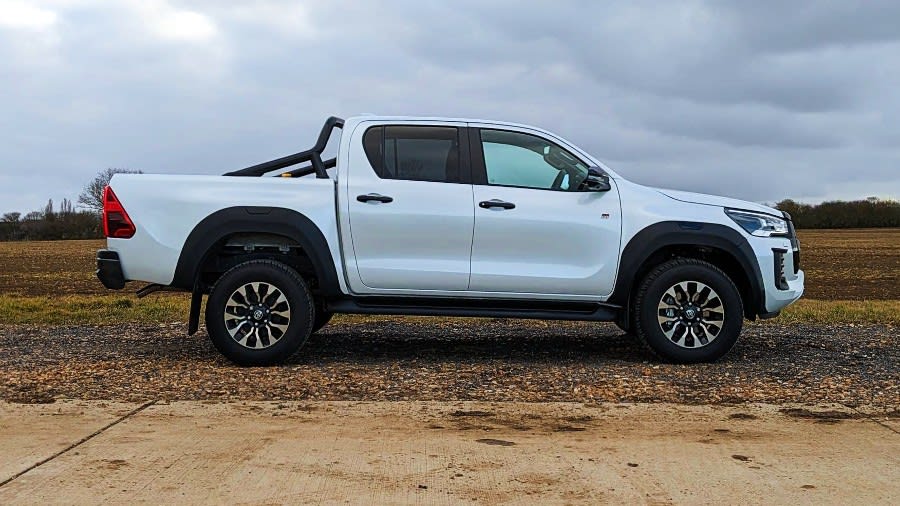
Elsewhere in the Hilux range, there’s everything from single cab, club cab or double cab options, manual and automatic gearboxes, 2.4 or 2.8-litre diesel engines, and four trim levels to choose from. These run from commercial-friendly Active trim to the luxurious Invincible X, with the GR Sport sitting just above at the very top of the range.
All models will happily tow a 3.5-tonne trailer and carry a payload over a tonne. But it’s only this GR Sport that tries to look like a hot hatch while weighing 2.3 tonnes and, with paltry 17-inch alloy wheels underneath enormous extended wheel arches, it doesn’t quite pull it off.
Key Features
The Dakar-rally winning Hilux has a 3.5-litre V6 engine mounted right in the middle of the pickup that, in standard road form, puts out 415hp, but Toyota won’t tell us what it produces in race mode. Suspension upgrades give travel of 350mm, with 37-inch tall and 320mm tyres providing traction in hostile and challenging environments.
The Hilux GR Sport has none of that. Aside from the cosmetic changes, all that you’ll find are monotube shock absorbers on the rear leaf springs that improve damping performance by reacting more quickly and spreading the load over a wider area. There’s also a stiffer setup to the double-wishbone front suspension, which Toyota has highlighted by painting the springs red.
Performance & Drive
Firm suspension is always an issue with pickup trucks. Balancing the need for some degree of passenger comfort with the ability to carry a tonne or so of cargo and tow a 3.5-tonne trailer means something has to give, and it’s the human cargo that usually loses out. Adding even-stiffer suspension is a brave move from Toyota, but it’s almost pulled it off.
Out on the motorway, the Hilux GR Sport is pleasing, feeling little different to every other Hilux, which means it jiggles around a little bit, but by pickup standards, it’s reasonably refined. It falls apart on slower roads, where the front-end stiffness makes it feel sharper in the corners but makes the cabin environment a bone-rattling endurance trial.
Yes, it resists roll in the corners better than any other Hilux, and there’s a little more steering feel through the wheel, but the all-terrain tyres are a limiting factor to just how much fun you can have. All-wheel drive ensures plenty of grip off-road, but the rear-wheel drive on-road mode means it’s easy to light up an inside rear wheel in corners. To be fair, it’s no worse — or better — than most of its rivals in that regard.
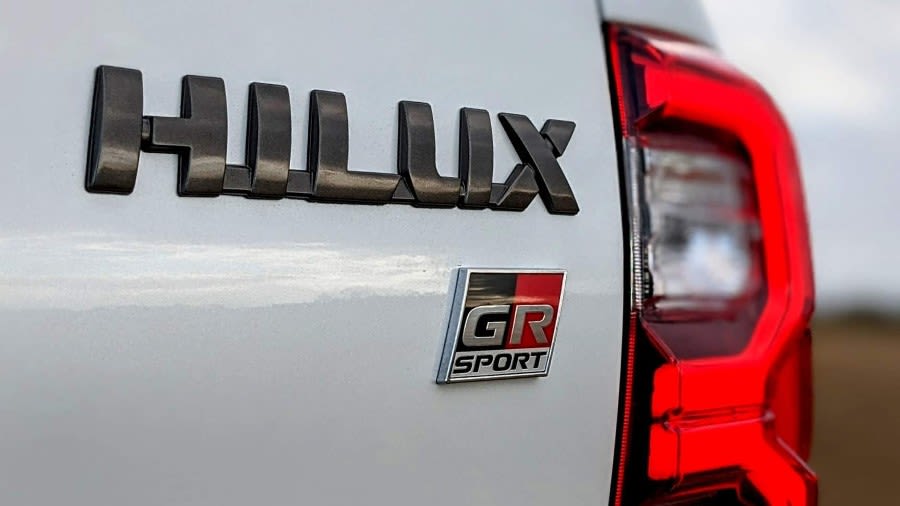
While we’ve not tackled anything too trying, it doesn’t appear as if the Hilux’s off-road capabilities have been dented at all; it’s still got the same long-travel suspension giving ground clearance of 310mm, the same approach and departure angles (29° and 26°), and the same 700mm wading depth.
The 2.8-litre diesel engine gave the Hilux the performance it needed, with 204hp and 500Nm of torque improving over the legacy 2.4-litre’s 150hp output, but that’s only enough to provide it with competitive rather than class-leading performance.
The 0-62mph dash takes 10.7 seconds, but it feels longer as the engine has to be worked hard to get there, and it’s a noisy, unrefined beast when pressing on. Happily, it’s calm and quiet when cruising, which is where, surprisingly, the Hilux GR Sport is at its best.
Running Costs
Being a top-of-the-range model, the GR Sport attracts a significant price tag. At £40,528 (plus VAT), it’s more than £1,800 more expensive than the Invincible X on which it’s based. That translates into higher leasing payments as well, with monthly costs being around £50 a month higher at the time of writing — but check the latest rates.
Anything that weighs 2.3 tonnes and is powered by a 2.8-litre engine won't be economical either, but the Hilux GR Sport doesn’t come out too badly there, at least when compared to its rivals. With an official economy figure of 28.5-30mpg, it could be much worse. Pleasingly after hundreds of miles on mixed roads, our test model’s onboard computer showed we’d managed 29.6mpg, so bang on target.
Company car drivers will benefit from a fixed BIK rate, meaning the monthly tax bill for a 40% taxpayer will be around £130 a month. A similarly specified Audi Q5 would be around £600 a month, so the savings for picking a commercial vehicle are significant, although you do give up a lot of performance, comfort and refinement.
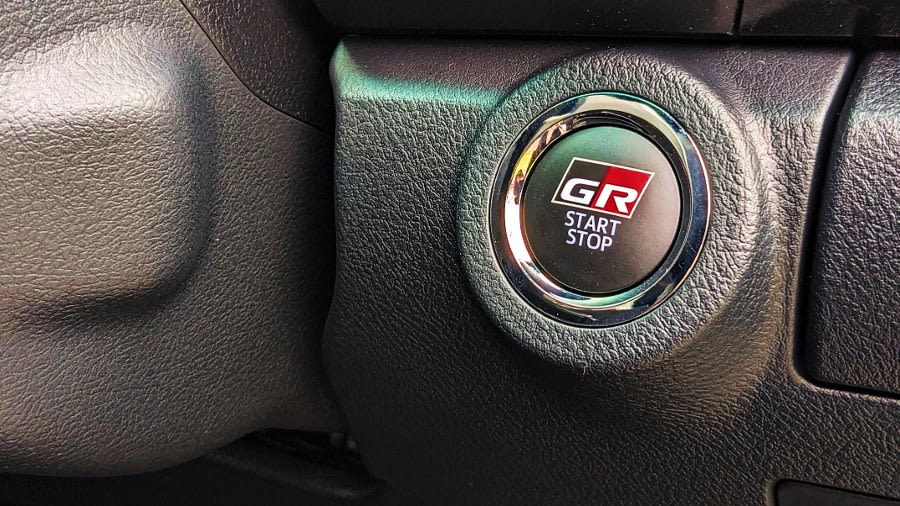
Interior and Technology
Adding some deeply sculpted sports seats in a pickup truck is somewhat incongruous, but it works. The cabin of the Hilux GR Sport looks great, with faux-carbon fibre trim, red highlights, leather, suede and GR badges adorning an otherwise functional and inoffensive interior.
Mounted high up on the centre console is an 8.0-inch infotainment screen that’s a generation behind the latest cars and trucks, but it’s functional and, for the most part, easy to use. Android Auto and Apple CarPlay are also in place, so you can always eschew the Toyota system and use what you’re used to.
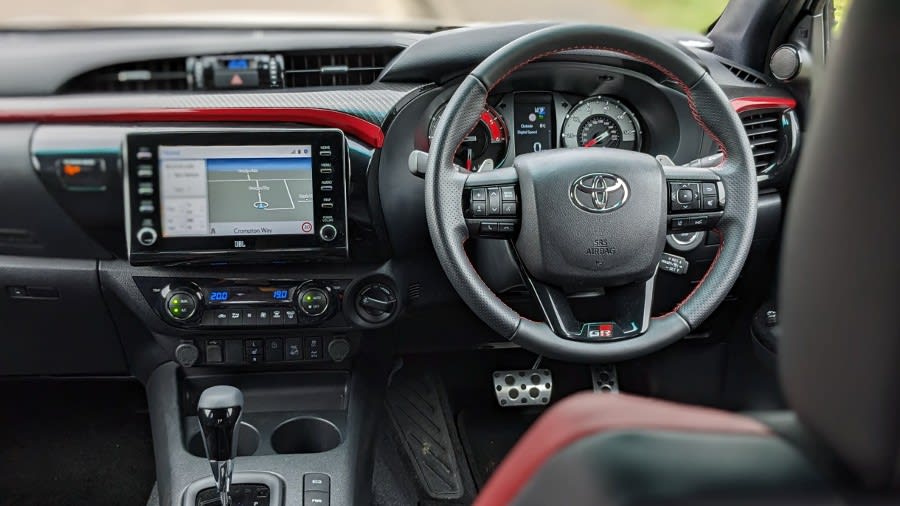
The leather and suede-clad seats are comfortable and supportive, as you’d hope for, although the plush seats in the regular models are, arguably, a little more cosseting. You won’t be short of headroom or shoulder room in the front either, with the Hilux offering enough space for even the tallest. The rear is much the same, with three seats offering sufficient head and legroom for most. The middle passenger might feel they’ve got a slightly rough deal, but that’s true in most vehicles.
The cabin has plenty of storage for bits and pieces, with door bins large enough to take bottles, cup holders all around, and a decent glove box. The rear seat can fold to allow access to a small but secure storage area, too.
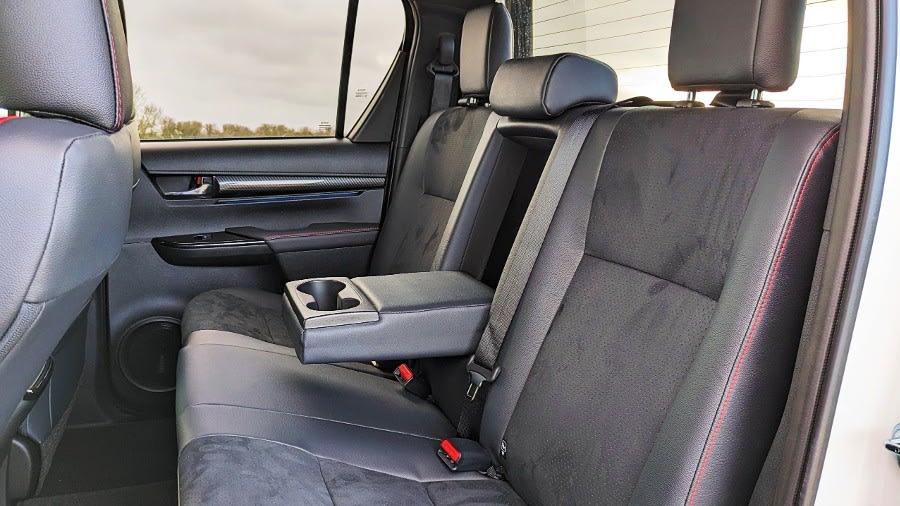
Payload and Practicality
Despite being the ‘hot’ model, the Hilux GR Sport can still carry a tonne of cargo in its load box — just. At 1,010kg, the payload limit squeezes over the VAT man’s arbitrary one-tonne requirement.
The load deck is almost square, measuring 1,525mm long and 1,540mm wide. That's midfield in the sector, with a smaller load box than you’ll find on a Ford Ranger or Volkswagen Amarok but a larger bed than the Isuzu D-Max provides.
Every model in the Hilux range will happily carry a tonne, and they’ll all tow 3.5 tonnes as well. However, with a gross train weight on the GR Sport of 6,300kg, it can’t manage both simultaneously. With a kerb weight of 2,325kg, you’ll have 3,975kg to split between the pickup and its trailer.

Safety
Euro NCAP hasn’t put the latest Toyota Hilux through its comprehensive testing regime, but its Australian cousins at ANCAP have. Its broadly similar testing process resulted in the Hilux being awarded the full five stars for safety, and there's no reason to think the UK score would be any different.
Toyota loads the Hilux with a seemingly endless array of safety equipment, including automatic emergency braking, front and rear parking sensors, a reversing camera, adaptive cruise control, trailer sway control, lane departure warning, lane keeping assist and two Isofix attachment points for child seats.
However, not every model in the Hilux range gets the whole gamut of kit, so if you’re thinking of a different Hilux model, check what’s included.
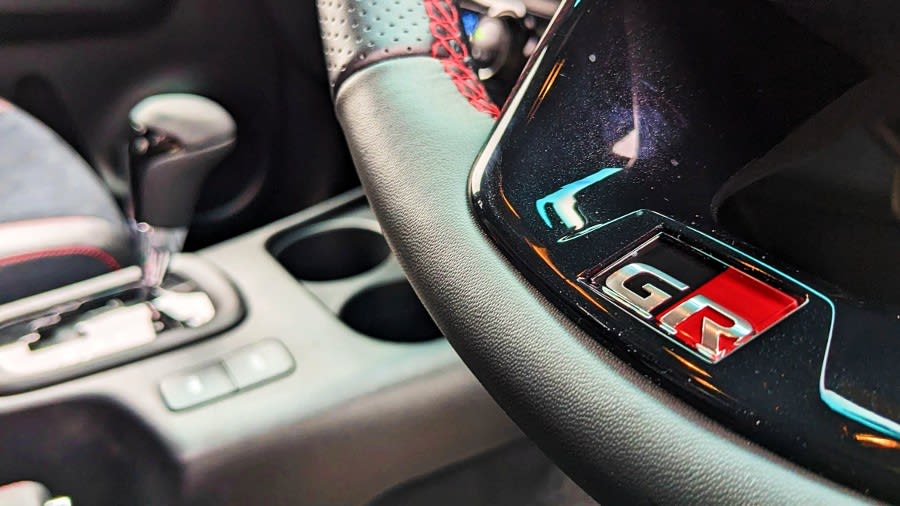
Options
As the highest point in the Hilux range, there’s not much missing from the GR Sport. You’ll find climate control, navigation, adaptive cruise control, a reversing camera, leather and suede trim, heated seats, an 8.0-inch infotainment system, a JBL sound system and even a sports bar included as standard.
That means the options list is relatively short, with some cargo box bed liners and paint colours all you get to play with. You can have the GR Sport in plain white at no cost — and that looks quite good thanks to all the black trim added to the pickup — or pay £604 plus VAT for one of three different shades of grey or a bold blue metallic.
Rival Pickups
There aren’t any road-focused performance pickups on the market, which makes direct rivals tricky. But then the Hilux GR Sport isn’t really a sports model, so that opens things up. The Ford Ranger Raptor is the closest in concept, but its 3.0-litre V6 petrol engine and properly tuned chassis and suspension are a step up from the Hilux. It’s also a step up in price, at around £60,000.
The new Ford Ranger will soon provide a Platinum model, which, while not specifically a high-performance model, will be fitted with the manufacturer's smooth 3.0-litre V6 diesel engine and a road-focussed combination of wheels and suspension. It’ll be plush, too, topping the Ranger model lineup.
Volkswagen has split its Amarok range into an off-road PanAmericana model and an on-road Aventura trim level. The latter is an obvious rival and offers more potent performance and a more luxurious cabin, but the payload limits are low and will attract the attention of HMRC.
The SsangYong Musso, while capable off-road, is more at home on it. A lower ride height gives more stable handling, while the car-like interior is loaded with equipment and tech. The ride quality is compromised, though.

Verdict
We love how the Hilux GR Sport looks — although we’d like to see larger wheels and a wider track so those wheel arches are filled a little more — and the interior is glorious if a little bit dated.
We also love how capable the Hilux is off-road, and it’s pleasing to see that Toyota hasn’t sacrificed that in the name of on-road performance.
But what we don’t like are the suspension changes. If we could have the Invincible X with the cosmetic upgrades to the GR Sport, then it would be a winner. As it stands, you might just be better off saving just a little bit of cash and opting for the next rung down the Hilux ladder.
Where to next?
View latest Toyota Hilux leasing deals - from just £391.45 per month inc VAT**.
Call us on 0118 3048 688 or hit the green 'Enquire' button for more details.
Looking for a great leasing deal? Check out our incredible range of car lease deals.
New Pick Up? Read our latest Car Reviews and find the right model for you.
Want to know more about leasing? Take a look at our comprehensive Leasing Guides.
Interested in everything motoring? Why not catch up on all the latest Car Leasing News.
**Score based on Select’s unique meta score analysis, taking into account the UK’s top leading independent car website reviews of the Toyota Hilux Pick Up
**Correct as of 20/06/2023. Based on 9 months initial payment, 5,000 miles over a 48 month lease. Initial payment equivalent to 9 monthly payments or £3,523.32 (Plus admin fee) Ts and Cs apply. Credit is subject to status.





















